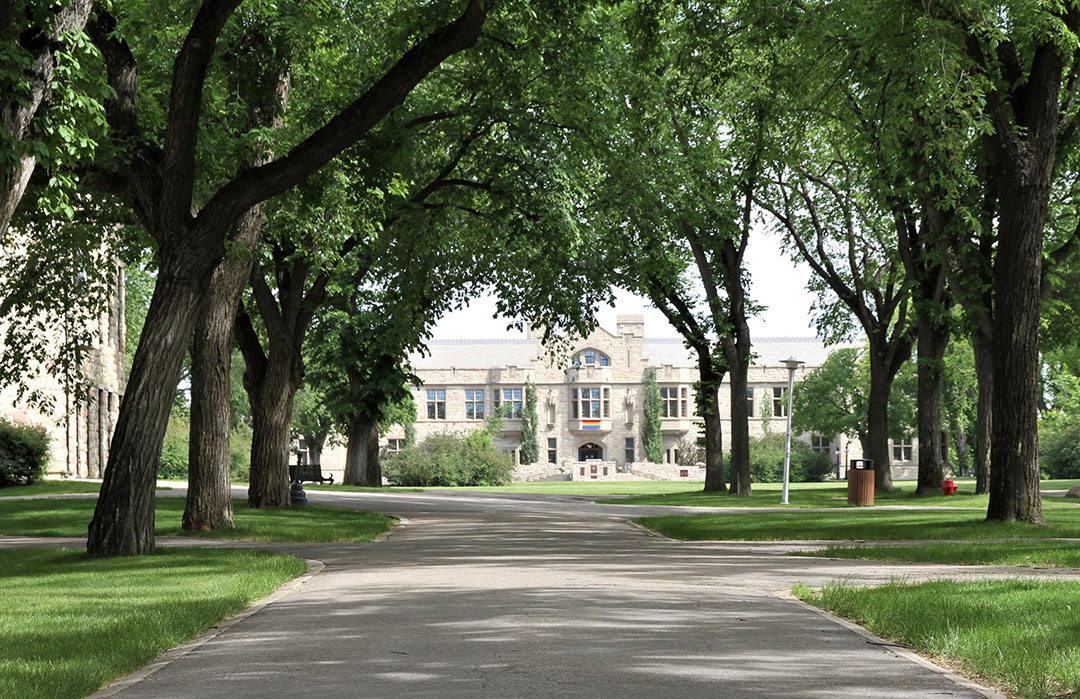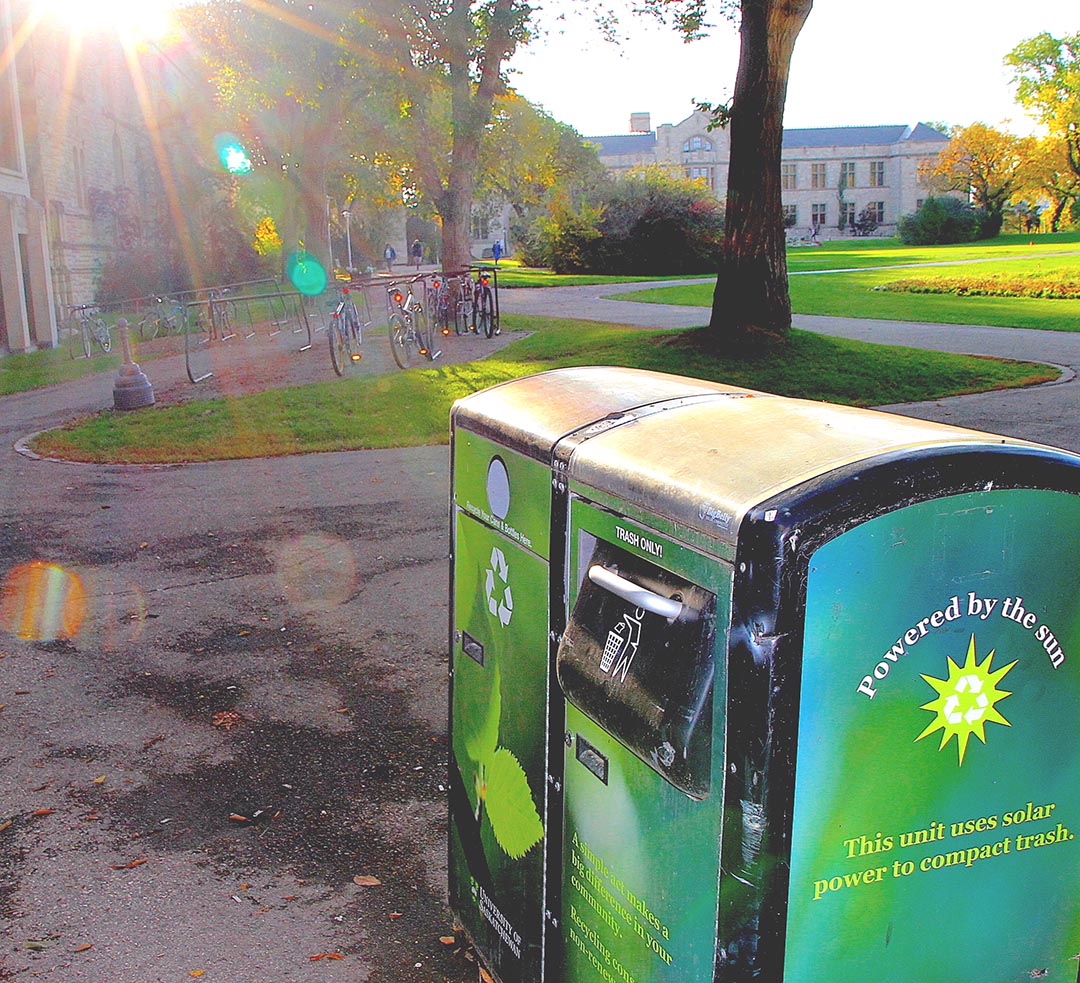USask sustainability initiatives powering progress on campus
From ensuring campus facilities are as efficient and environmentally friendly as possible, to integrating sustainability into the educational experience to contributing internationally, to achieving the United Nations (UN) 2030 sustainable development goals (SDGs), the University of Saskatchewan’s (USask) new Sustainability Strategy touches all facets of its operations.
By Sarath PeirisSwitching the university’s source of power towards more solar power generation and exploring the viability of alternatives such as geothermal heat are also part of the overall Path to Zero plan. (Photo: James Shewaga)
• Among major initiatives underway is the Path to Zero plan developed by Facilities Sustainability and Engineering Manager Robert Bierman. It builds on USask’s 2030 goal of cutting campus greenhouse gas emissions (GHG) 45 per cent from 2010 levels, with a longer-term objective of reaching net-zero emissions by 2050.
“A key step on our path to zero is fine-tuning how our existing buildings operate to use less energy, while at the same time ensuring occupant comfort,” said Bierman. “Doing the most we can with the least amount of energy input.”
In addition to current measures, such as ongoing improvements to existing buildings, the longer-term strategy involves ensuring that any new building supports the net zero goal.
“The best new building is zero-energy, meaning it produces the same amount of energy as it consumes,” said Bierman. “Typically, it will have a lot of insulation, a lot of automation, and is only heated or cooled when it’s occupied. It will be augmented with its own non-emitting power generation—typically solar.”
Eventually, Bierman sees USask reducing its indirect GHG emissions that come from the generation of electricity that the university consumes, through a combination of better building and benefiting from the efforts made by SaskPower as it moves away from coal-fired generation to greener methods. Switching the university’s source of power towards more solar power generation and exploring the viability of alternatives such as geothermal heat are also part of the overall plan.
USask has a district heating system that’s based on burning natural gas to boil water and create steam that’s distributed centrally for heating buildings across campus. Bierman will consult energy experts on the viability of creating a heating micro-grid system where, for instance, heat from ice making at Merlis Belsher Place can be transferred to warm the swimming pools and, instead of operating chillers to cool down computer servers, the heat can be diverted for use elsewhere.
“We need to recognize that unless we start today toward net zero by 2050, it won’t happen,” he said.

• Dr. Nancy Turner (PhD), director of teaching and learning enhancement at USask, said advancing the education strand of the sustainability strategy involves three key aspects, starting with strengthening sustainability focused academic programs, such as in the School of Environment and Sustainability.
“The other aspect we’re really interested in is opening up more opportunities for students in non-sustainability-specific programs to learn about SDGs, and how their discipline contributes overall to sustainability and meetings the targets of the SDGs,” said Turner.
Given the breadth of the 17 SDGs and the 169 associated targets, any discipline on campus can connect to at least some of the targets on the list, she said. Her team is working with faculty members to support more infusion of SDGs and sustainability into non-traditional areas of study.
“Faculty will identify the SDGs that are relevant to their academic discipline,” she said. “A big part of what we’re looking at is to produce graduates from all disciplines who value sustainability in practice and are able to contribute to global goals.”
Another component being considered is creating co-curricular opportunities for all interested students to learn about SDGs alongside their formal curriculum, culminating in a credential related to sustainability. This opportunity could eventually be aligned with an institutional micro-credentialing framework and expanded to include people outside the institution.
Individuals within Turner’s team have envisioned the program involving a collaborative capstone project in which students work in a multidisciplinary team with a community partner to address an area of sustainability, and would receive formal recognition with a certificate upon project completion.
USask hosts an EcoHack event annually. This is an immersive multi-day experience in which students from various degree programs collaborate with community partners to solve a real-world problem. In 2020, the focus was on topics that fit within the City of Saskatoon’s theme of The Social Impacts of Climate Change.

• Through initiatives led by International Office Director Dr. Meghna Ramaswamy (PhD) and others, the university has established several local, national and international partnerships in support of USask’s goal of being a world leader among post-secondary institutions in achieving the UN development goals.
USask’s People Around the World (PAW) conference for the past three years has featured SDGs as its theme, attracting high-profile participants from around the globe to discuss how citizens can meaningfully integrate these goals into their personal and professional lives and communities.
Provincially, Ramaswamy chairs a working group, established through the Ministry of Advanced Education and consisting of all Saskatchewan post-secondary institutions, that aims to advance international education.
“Through this table, we can work with the government to improve our understanding and awareness of research and SDG projects and events so that we can co-ordinate events within the province. This engages the wider community and also advances dialogue on sustainable development,” she said.
The university is also a member of a UN initiative called the Sustainable Development Solutions Network (SDSN) with global signatories. Under the SDSN umbrella, USask student volunteer co-ordinators will set up a hub on campus—a community of students who are interested in sustainable development—to meet, discuss what’s happening at other universities, learn about SDGs through workshops and events, and develop solutions.
Ramaswamy also contributed through SDSN to a widely used practical guide—published by the UN—on how universities can accelerate education for sustainable development. In addition, the International Office has embarked on a series of SDG webinars with a select group of universities in the Philippines, China and Taiwan.
USask is also a partner in the Sustainability and Education Policy Network that launched the Monitoring and Evaluation of Climate Change Education (MECCE) project to improve climate literacy and action by enhancing climate change education, training, and public awareness. The project’s more than 80 international partners and collaborators include the United Nations (UN) Framework Convention on Climate Change, the UN Educational, Scientific and Cultural Organization (UNESCO), the UNESCO Global Education Monitoring Report, the Intergovernmental Panel on Climate Change, and Environment and Climate Change Canada. MEECE’s leadership includes Director Dr. Marcia McKenzie (PhD) of USask’s College of Education.
Sarath Peiris is a former USask communications specialist and Saskatoon-based freelance writer.

